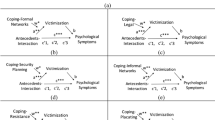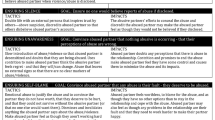Abstract
The purpose of the current investigation was to examine the mediational role of attributions and emotional reactions to partner violence in the relationship between violence severity and frequency, and women's intentions to leave abusive relationships permanently. The results of separate regression analyses indicated that perceived increases in the frequency and severity of violence over time, but not absolute levels of violence, were significantly related to women's attributions for the violence, the severity of nervousness reported subsequent to a violent episode, and the intention to leave the abusive partner permanently. Attributions of partner causality and responsibility for violence were significantly related to nervous reactions and the intention to leave the abusive partner permanently. As predicted by the attributional model tested, the relationship between perceived increases in violence over time and the intention to leave the abusive partner permanently was completely mediated by the extent to which women explained or attributed the causes of the violence to the partner that were stable and global, and attributed blameworthiness, malicious intent, and selfish motivations to the partner for his use of violence.
Similar content being viewed by others
REFERENCES
Aguirre, B. E. (1985). Why do they return? Abused women in shelters. Social Work, 30, 350–354.
Arias, I., & Beach, S. R. H. (1987). Evaluations of physical aggression among intimate dyads. Journal of Family Violence, 2, 139–149.
Arias, I., Lyons, C. M., & Street, A. E. (1997). Individual and marital consequences of victimization: Moderating effects of relationship efficacy and spouse support. Journal of Family Violence, 12, 193–210.
Baron, R. M., & Kenny, D. A. (1986). Themoderator-mediator variable distinction in social psychological research: Conceptual, strategic, and statistical considerations. Journal of Personality and Social Psychology, 51, 1173–1182.
Cascardi, M., Langhinrichsen, J., & Vivian, D. (1992). Marital aggression: Impact, injury, and health correlates for husbands and wives. Archives of Internal Medicine, 152, 1178–1184.
Dutton, D. G., & Hemphill, K. J. (1992). Patterns of socially desirable responding among perpetrators and victims of wife assault. Violence and Victims, 7, 29–39.
Ferraro, K. J., & Johnson, J. M. (1983). How women experience battering: The process of victimization. Social Problems, 30, 325–339.
Fincham, F. D., & Bradbury, T. N. (1992). Assessing attributions in marriage: The Relationship Attribution Measure. Journal of Personality and Social Psychology, 62, 457–468.
Fincham, F. D., & Bradbury, T. N. (1993). Marital satisfaction, depression, and attributions: A longitudinal analysis. Journal of Personality and Social Psychology, 64, 442–452.
Frieze, I. H. (1979). Perceptions of battered wives. In I. H. Frieze, D. Bar-Tal, & J. S. Carroll (Eds.), New approaches to social problems (pp. 79–108). San Francisco: Jossey-Bass.
Frieze, I. H. (1987). Perceptions of battering by battered women. Paper presented at the Third National Family Violence Research Conference, July 1987, University of New Hampshire.
Gelles, R. J. (1976). Abused wives: Why do they stay? Journal of Marriage and the Family, 38, 659–668.
Gondolf, E. W. (1988). The effect of batterer counseling on shelter outcome. Journal of Interpersonal Violence, 3, 275–289.
Herbert, T. B., Silver, R. C., & Ellard, J. H. (1991). Coping with an abusive relationship: How and why do women stay? Journal of Marriage and the Family, 53, 311–325.
Hilberman, E., & Munson, K. (1977-1978). Sixty battered women. Victimology: An International Journal, 2, 460–470.
Hilbert, J. C., & Hilbert, H. C. (1984). Battered women leaving shelters: Which way do they go? A discriminant functional analysis. Journal of Applied Social Sciences, 8, 291–297.
Holtzworth-Munroe, A. (1988). Causal attributions in marriage: Theoretical and methodological issues. Clinical Psychology Review, 8, 331–344.
Holtzworth-Munroe, A., Smutzler, N., & Sandin, E. (1997). A brief review of the research on husband violence. Part II: The psychological effects of husband violence on battered women and their children. Aggression and Violent Behavior, 2, 179–213.
Hotaling, G., & Sugarman, D. (1986). An analysis of risk markers in husband-to-wife violence: The current state of knowledge. Violence and Victims, 1, 101–124.
Hotaling, G., & Sugarman, D. (1990). A risk marker analysis of assaulted wives. Journal of Family Violence, 5, 1–13.
Judd, C. M, & Kenny, D. A. (1981). Process analysis: Estimating mediation in evaluation research. Evaluation Research, 5, 602–619.
Miller, D. T., & Porter, C. A. (1983). Self-blame in victims of violence. Journal of Social Issues, 39, 139–152.
Montgomery, D. C, & Peck, E. A. (1992). Introduction to linear regression analysis, 2nd ed. New York: John Wiley & Sons.
Pagelow, M. D. (1981). Woman-battering: Victims and their experiences. Beverly Hills: Sage.
Plichta, S. B. (1996). Violence and abuse: Implications for women's health. In M. M. Falik & K. S. Collins (Eds.), Women's health: The Commonwealth Fund Survey (pp. 237–270). Baltimore: The Johns Hopkins University Press.
Snyder, D. K., & Scheer, N. S. (1981). Predicting disposition following brief residence at a shelter for battered women. American Journal of Community Psychology, 9, 559–566.
Straus, M. A. (1990). The Conflict Tactics Scales and its critics: An evaluation and new data on validity and reliability. In M. A. Straus & R. J. Gelles (Eds.), Physical violence in American families: Risk factors and adaptations to violence in 8,145 families (pp. 49–73). New Brunswick, NJ: Transaction Publishers.
Straus, M. A., & Gelles, R. J. (1986). Societal change and change in family violence from 1975 to 1985 as revealed by two national surveys. Journal of Marriage and the Family, 48, 465–479.
Straus, M. A., Gelles, R. J., & Steinmetz, S. K. (1980). Behind closed doors: violence in the American family. New York: Anchor Books.
Strube, M. J. (1988). The decision to leave an abusive relationship: Empirical evidence and theoretical issues. Psychological Bulletin, 104, 236–250.
Strube, M. J., & Barbour, L. S. (1983). The decision to leave an abusive relationship: Economic dependence and psychological commitment. Journal of Marriage and the Family, 45, 785–793.
Vivian, D., & Langhinrichsen-Rohling, J. (1994). Are bi-directionally violent couples mutually victimized? A gender-sensitive comparison. Violence and Victims, 9, 107–123.
Weiner, B. (1986). An attributional theory of motivation and emotion. New York: Springer-Verlag.
Author information
Authors and Affiliations
Rights and permissions
About this article
Cite this article
Pape, K.T., Arias, I. The Role of Perceptions and Attributions in Battered Women's Intentions to Permanently End Their Violent Relationships. Cognitive Therapy and Research 24, 201–214 (2000). https://doi.org/10.1023/A:1005498109271
Issue Date:
DOI: https://doi.org/10.1023/A:1005498109271




